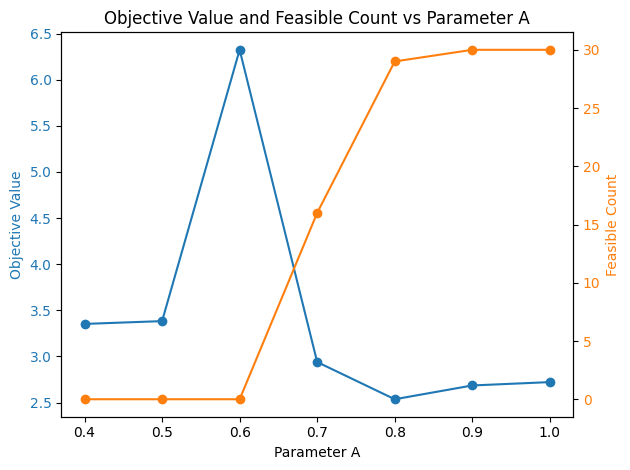QUBOのハイパーパラメータサーチ#
ここでは、QUMOモデルのハイパーパラメータ空間を探索するために、MINTOがどのように使えるかを簡単な例を通して説明します。
この例では、2次割当定式化を用いて巡回セールスマン問題を扱います。
巡回セールスマン問題についての詳細は、ぜひ他のリソースを参照ください。
import minto
import matplotlib.pyplot as plt
import jijmodeling as jm
import minto.problems.tsp
tsp = minto.problems.tsp.QuadTSP()
tsp_problem = tsp.problem()
n = 8
tsp_data = tsp.data(n=n)
tsp_problem
\[\begin{split}\begin{array}{cccc}\text{Problem:} & \text{QuadTSP} & & \\& & \min \quad \displaystyle \sum_{i = 0}^{n - 1} \sum_{j = 0}^{n - 1} d_{i, j} \cdot \sum_{t = 0}^{n - 1} x_{i, t} \cdot x_{j, \left(t + 1\right) \bmod n} & \\\text{{s.t.}} & & & \\ & \text{one-city} & \displaystyle \sum_{\ast_{1} = 0}^{n - 1} x_{i, \ast_{1}} = 1 & \forall i \in \left\{0,\ldots,n - 1\right\} \\ & \text{one-time} & \displaystyle \sum_{\ast_{0} = 0}^{n - 1} x_{\ast_{0}, t} = 1 & \forall t \in \left\{0,\ldots,n - 1\right\} \\\text{{where}} & & & \\& x & 2\text{-dim binary variable}\\\end{array}\end{split}\]
interpreter = jm.Interpreter(tsp_data)
instance = interpreter.eval_problem(tsp_problem)
QUBO formulation#
\[
E(x; A) = \sum_{i=0}^{n-1} \sum_{j=0}^{n-1} d_{ij} \sum_{t=0}^{n-1} x_{it} x_{j, (t+1)\mod n}
+ A \left[
\sum_i \left(\sum_{t} x_{i, t} - 1\right)^2 + \sum_t \left(\sum_{i} x_{i, t} - 1\right)^2
\right]
\]
The parameter \(A\) is a hyperparameter that controls the strength of the constraints.
In OMMX, we can tune this parameter using the .to_qubo(uniform_penalty_weight=...) method and argument uniform_penalty_weight to set the value of \(A\).
import ommx_openjij_adapter as oj_ad
parameter_values = [0.4, 0.5, 0.6, 0.7, 0.8, 0.9, 1.0]
experiment = minto.Experiment(auto_saving=False, verbose_logging=False)
for A in parameter_values:
with experiment.run() as run:
ox_sampleset = oj_ad.OMMXOpenJijSAAdapter.sample(instance, uniform_penalty_weight=A, num_reads=30)
run.log_sampleset(ox_sampleset)
run.log_parameter("A", A)
table = experiment.get_run_table()
table
| sampleset_0 | parameter | metadata | ||||||||
|---|---|---|---|---|---|---|---|---|---|---|
| num_samples | obj_mean | obj_std | obj_min | obj_max | feasible | name | A | run_id | elapsed_time | |
| run_id | ||||||||||
| 0 | 30 | 3.353026 | 0.499013 | 2.355019 | 4.268100 | 0 | 0 | 0.4 | 0 | 0.042427 |
| 1 | 30 | 3.383542 | 0.700817 | 2.340510 | 4.839428 | 0 | 0 | 0.5 | 1 | 0.034157 |
| 2 | 30 | 6.323973 | 1.107701 | 4.669342 | 8.462845 | 0 | 0 | 0.6 | 2 | 0.036005 |
| 3 | 30 | 2.939773 | 0.576959 | 2.220747 | 4.255948 | 16 | 0 | 0.7 | 3 | 0.028858 |
| 4 | 30 | 2.536650 | 0.234261 | 2.220747 | 3.052677 | 29 | 0 | 0.8 | 4 | 0.028297 |
| 5 | 30 | 2.686100 | 0.275722 | 2.220747 | 3.506836 | 30 | 0 | 0.9 | 5 | 0.021842 |
| 6 | 30 | 2.722490 | 0.341214 | 2.220747 | 3.609280 | 30 | 0 | 1.0 | 6 | 0.022454 |
fig, ax1 = plt.subplots()
# First y-axis for objective value
ax1.set_xlabel("Parameter A")
ax1.set_ylabel("Objective Value", color="tab:blue")
ax1.plot(table["parameter"]["A"], table["sampleset_0"]["obj_mean"], "-o", color="tab:blue")
ax1.tick_params(axis="y", labelcolor="tab:blue")
# Second y-axis for feasible count
ax2 = ax1.twinx()
ax2.set_ylabel("Feasible Count", color="tab:orange")
ax2.plot(table["parameter"]["A"], table["sampleset_0"]["feasible"], "-o", color="tab:orange")
ax2.tick_params(axis="y", labelcolor="tab:orange")
plt.title("Objective Value and Feasible Count vs Parameter A")
fig.tight_layout()

